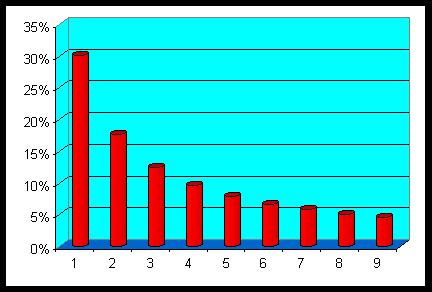|
Copyright ©2003 by Paul Niquette. All rights reserved. |
|
Back before computers and calculators, serious arithmetic meant using logarithms. Remember? It was Newcomb who first observed that the phenomenon has something to do with in each numerical entry. Exclamation point alert: Those first digits are not uniformly distributed among the ciphers! Now, we have noted elsewhere that by definition the first digit of a decimal number cannot be a zero. That leaves nine ciphers, though, and one might expect each of them to appear about one out of nine times in that first position. For each, about 11% would make sense. Not so. The cipher 1 is almost three times more likely to take the leftmost position than you would expect by chance -- in 30% of numerical entries. The cipher 2 is next in order, occupying close to 18% of the first positions, and so forth to the cipher 9 at well under 5% thereby getting less than half its fair share. In 1938, Frank Benford confirmed Newcomb's observations, and found the same proportions to exist in a whole lot of numbers other than logarithms. Benford conducted a comprehensive investigation of numerical lists covering a variety of natural and man-made phenomena, including... addresses,
The result is now widely known as Benford's Law.
|

